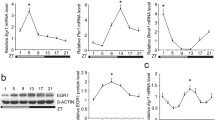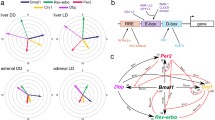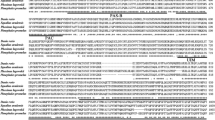Abstract
Glucocorticoids have been recently proposed as input signals of circadian system, although the underlying molecular mechanism remains unclear. This work investigates the role of glucocorticoids as modulators of clock genes expression in the liver of goldfish. In fish maintained under a 12L:12D photoperiod, an intraperitoneal injection at Zeitgeber Time 2 of a glucocorticoid analog, dexamethasone (1 μg/g body weight) induced per1 genes while decreased gbmal1a and gclock1a expression in the liver at 8 h post-injection. A 4-h in vitro exposure of goldfish liver to cortisol (0.1–10 μM) also induced gper1 genes in a concentration-dependent manner. Similarly, the exposure of the goldfish cultured liver to dexamethasone produced a concentration-dependent induction of gper1 genes. Moreover, this glucocorticoid analog led to a decrease in gbmal1a and gclock1a transcripts, while the other clock genes analyzed were unaffected. The induction of gper1a and gper1b by dexamethasone in vitro was observed at short times (2 h), whereas the reductions of gbmal1a and gclock1a transcripts needed longer exposure times (8 h) to the glucocorticoid to be significant. Additionally, a 2-h exposure to dexamethasone in the liver culture was enough to extend the induction of per genes for more than 12 h. Present results indicate that gper1 genes are targets for glucocorticoids in the regulation of goldfish hepatic oscillator, as previously reported in mammals, suggesting a conserved role of glucocorticoids in the functional organization of the peripheral circadian system in vertebrates. The repression of clock1a and bmal1a is not so well established, and suggests that other clock genes could be glucocorticoid targets in the goldfish liver.





Similar content being viewed by others
Abbreviations
- BMAL:
-
Brain and muscle ARNT-like 1
- CLOCK:
-
Circadian locomotor output cycles Kaput
- CRY:
-
Cryptochrome
- DEX:
-
Dexamethasone
- DMEM:
-
Dulbecco’s modified eagle medium
- GRE:
-
Glucocorticoids response element
- IP:
-
Intraperitoneal
- PER:
-
Period
- ROR:
-
Retinoic acid related orphan receptor
- RT-qPCR:
-
Real-time quantitative polymerase chain reaction
- SCN:
-
Suprachiasmatic nucleus
- SNK:
-
Student Newman Keuls
- ZT:
-
Zeitgeber time
References
Akashi M, Nishida E (2000) Involvement of the MAP kinase cascade in resetting of the mammalian circadian clock. Genes Dev 14:645–649
Albrecht U (2012) Timing to perfection: the biology of central and peripheral circadian clocks. Neuron 74:246–260
Al-Safadi S, Branchaud M, Rutherford S, Amir S (2015) Glucocorticoids and stress-induced changes in the expression of PERIOD1 in the rat forebrain. PLoS One 10:e0130085
Aluru N, Vijayan MM (2007) Hepatic transcriptome response to glucocorticoid receptor activation in rainbow trout. Physiol Genomics 31:483–491
Balsalobre A, Brown SA, Marcacci L et al (2000) Resetting of circadian time in peripheral tissues by glucocorticoid signaling. Science 289:2344–2347
Bernier NJ, Lin X, Peter RE (1999) Differential expression of corticotropin-releasing factor (CRF) and urotensin I precursor genes, and evidence of CRF gene expression regulated by cortisol in goldfish brain. Gen Comp Endocrinol 116:461–477
Cahill GM (2002) Clock mechanisms in zebrafish. Cell Tissue Res 309:27–34
Carneiro BTS, Araujo JF (2009) The food-entrainable oscillator: a network of interconnected brain structures entrained by humoral signals? Chronobiol Int 26:1273–1289
Cheon S, Park N, Cho S, Kim K (2013) Glucocorticoid-mediated Period 2 induction delays the phase of circadian rhythm. Nucl Acid Res 41:6161–6174
De Pedro N, Alonso-Gómez AL, Gancedo B et al (1997) Effect of alpha-helical-CRF[9–41] on feeding in goldfish: involvement of cortisol and catecholamines. Behav Neurosci 111:398–403
Dickmeis T, Lahiri K, Nica G et al (2007) Glucocorticoids play a key role in circadian cell cycle rhythms. PLoS Biol 5:e78
Dickmeis T, Weger BD, Weger M (2013) The circadian clock and glucocorticoids-interactions across many time scales. Mol Cell Endocrinol 380:2–15
Dunlap JC (1999) Molecular bases for circadian clocks. Cell 96:271–290
Falcón J, Besseau L, Sauzet S, Boeuf G (2007) Melatonin effects on the hypothalamo–pituitary axis in fish. Trends Endocrinol Metab 18:81–88
Feliciano A, Vivas Y, de Pedro N et al (2011) Feeding time synchronizes clock gene rhythmic expression in brain and liver of goldfish (Carassius auratus). J Biol Rhythms 26:24–33
Fukuhara C, Brewer JM, Dirden JC et al (2001) Neuropeptide Y rapidly reduces Period 1 and Period 2 mRNA levels in the hamster suprachiasmatic nucleus. Neurosci Lett 314:119–122
Fukuoka Y, Burioka N, Takata M et al (2005) Glucocorticoid administration increases hPer1 mRNA levels in human peripheral blood mononuclear cells in vitro or in vivo. J Biol Rhythms 20:550–553
Guillaumond F, Dardente H, Giguère V, Cermakian N (2005) Differential control of Bmal1 circadian transcription by REV-ERB and ROR nuclear receptors. J Biol Rhythms 20:391–403
Hastings M, O’Neill JS, Maywood ES (2007) Circadian clocks: regulators of endocrine and metabolic rhythms. J Endocrinol 195:187–198
Hirota T, Okano T, Kokame K et al (2002) Glucose down-regulates Per1 and Per2 mRNA levels and induces circadian gene expression in cultured Rat-1 fibroblasts. J Biol Chem 277:44244–44251
Kalsbeek A, Fliers E (2013) Daily regulation of hormone profiles. Handb Exp Pharmacol 217:185–226
Kalsbeek A, van der Spek R, Lei J et al (2012) Circadian rhythms in the hypothalamo–pituitary–adrenal (HPA) axis. Mol Cell Endocrinol 349:20–29
LaLone CA, Villeneuve DL, Olmstead AW et al (2012) Effects of a glucocorticoid receptor agonist, dexamethasone, on fathead minnow reproduction, growth, and development. Environ Toxicol Chem SETAC 31:611–622
Livak KJ, Schmittgen TD (2001) Analysis of relative gene expression data using real-time quantitative PCR and the 2(-Delta Delta C(T)) Method. Methods San Diego Calif 25:402–408
López-Olmeda JF, Blanco-Vives B, Pujante IM et al (2013) Daily rhythms in the hypothalamus-pituitary-interrenal axis and acute stress responses in a teleost flatfish, Solea senegalensis. Chronobiol Int 30:530–539
Mendoza J, Lopez-Lopez C, Revel FG et al (2011) Dimorphic effects of leptin on the circadian and hypocretinergic systems of mice. J Neuroendocrinol 23:28–38
Moore HA, Whitmore D (2014) Circadian rhythmicity and light sensitivity of the zebrafish brain. PLoS One 9:e86176
Nader N, Chrousos GP, Kino T (2010) Interactions of the circadian CLOCK system and the HPA axis. Trends Endocrinol Metab TEM 21:277–286
Nebzydoski SJ, Pozzo S, Nemec L et al (2010) The effect of dexamethasone on clock gene mRNA levels in bovine neutrophils and lymphocytes. Vet Immunol Immunopathol 138:183–192
Nikaido Y, Aluru N, McGuire A et al (2010) Effect of cortisol on melatonin production by the pineal organ of tilapia, Oreochromis mossambicus. Comp Biochem Physiol A: Mol Integr Physiol 155:84–90
Nisembaum LG, de Pedro N, Delgado MJ et al (2014a) Orexin as an input of circadian system in goldfish: effects on clock gene expression and locomotor activity rhythms. Peptides 52:29–37
Nisembaum LG, de Pedro N, Delgado MJ, Isorna E (2014b) Crosstalking between the “gut-brain” hormone ghrelin and the circadian system in the goldfish. Effects on clock gene expression and food anticipatory activity. Gen Comp Endocrinol 205:287–295
Nisembaum LG, Velarde E, Tinoco AB et al (2012) Light-dark cycle and feeding time differentially entrains the gut molecular clock of the goldfish (Carassius auratus). Chronobiol Int 29:665–673
Noche RR, Lu P-N, Goldstein-Kral L et al (2011) Circadian rhythms in the pineal organ persist in zebrafish larvae that lack ventral brain. BMC Neurosci 12:7
Oishi K, Amagai N, Shirai H et al (2005) Genome-wide expression analysis reveals 100 adrenal gland-dependent circadian genes in the mouse liver. DNA Res Int J Rapid Publ Rep Genes Genomes 12:191–202
Ota T, Fustin J-M, Yamada H et al (2012) Circadian clock signals in the adrenal cortex. Mol Cell Endocrinol 349:30–37
Panda S, Hogenesch JB, Kay SA (2002) Circadian rhythms from flies to human. Nature 417:329–335
Pratt WB, Kaine JL, Pratt DV (1975) The kinetics of glucocorticoid binding to the soluble specific binding protein of mouse fibroblasts. J Biol Chem 250:4584–4591
Reddy AB, Maywood ES, Karp NA et al (2007) Glucocorticoid signaling synchronizes the liver circadian transcriptome. Hepatology 45:1478–1488
Reppert SM, Weaver DR (2002) Coordination of circadian timing in mammals. Nature 418:935–941
Sánchez-Bretaño A, Gueguen M-M, Cano-Nicolau J et al (2015) Anatomical distribution and daily profile of gper1b gene expression in brain and peripheral structures of goldfish (Carassius auratus). Chronobiol Int 32:889–902
Schmutz I, Albrecht U, Ripperger JA (2012) The role of clock genes and rhythmicity in the liver. Mol Cell Endocrinol 349:38–44
Segall LA, Amir S (2010) Glucocorticoid regulation of clock gene expression in the mammalian limbic forebrain. J Mol Neurosci 42:168–175
So AY-L, Bernal TU, Pillsbury ML et al (2009) Glucocorticoid regulation of the circadian clock modulates glucose homeostasis. Proc Natl Acad Sci USA 106:17582–17587
Sujino M, Furukawa K, Koinuma S et al (2012) Differential entrainment of peripheral clocks in the rat by glucocorticoid and feeding. Endocrinology 153:2277–2286
Teles M, Boltaña S, Reyes-López F et al (2013) Effects of chronic cortisol administration on global expression of GR and the liver transcriptome in Sparus aurata. Mar Biotechnol N Y N 15:104–114
Tsang AH, Barclay JL, Oster H (2014) Interactions between endocrine and circadian systems. J Mol Endocrinol 52:R1–R16
Vatine G, Vallone D, Gothilf Y, Foulkes NS (2011) It’s time to swim! Zebrafish and the circadian clock. FEBS Lett 585:1485–1494
Velarde E, Haque R, Iuvone PM et al (2009) Circadian clock genes of goldfish, Carassius auratus: cDNA cloning and rhythmic expression of period and cryptochrome transcripts in retina, liver, and gut. J Biol Rhythms 24:104–113
Xydous M, Sekeri-Pataryas KE, Prombona A, Sourlingas TG (2012) Nicotinamide treatment reduces the levels of histone H3K4 trimethylation in the promoter of the mper1 circadian clock gene and blocks the ability of dexamethasone to induce the acute response. Biochim Biophys Acta 1819:877–884
Yamajuku D, Inagaki T, Haruma T et al (2012) Real-time monitoring in three-dimensional hepatocytes reveals that insulin acts as a synchronizer for liver clock. Sci Rep 2:439
Yamamoto T, Nakahata Y, Tanaka M et al (2005) Acute physical stress elevates mouse period1 mRNA expression in mouse peripheral tissues via a glucocorticoid-responsive element. J Biol Chem 280:42036–42043
Author information
Authors and Affiliations
Corresponding author
Ethics declarations
Ethical approval
All applicable international, national and/or institutional guidelines for the care and use of animals were followed. All procedures performed in studies involving animals were in accordance with the ethical standards of the institution or practice at which the studies were conducted. This article does not contain any studies with human participants performed by any of the authors.
Conflict of interest
No competing interest declared.
Funding
This research was supported by the Spanish Ministry of Economy and Competitiveness project (MINECO; AGL2013-46448-C3-2-R). A.S-B. was funded by FPI Grant (BES-2011-047620) from MINECO.
Additional information
Communicated by G. Heldmaier.
Electronic supplementary material
Below is the link to the electronic supplementary material.
Rights and permissions
About this article
Cite this article
Sánchez-Bretaño, A., Callejo, M., Montero, M. et al. Performing a hepatic timing signal: glucocorticoids induce gper1a and gper1b expression and repress gclock1a and gbmal1a in the liver of goldfish. J Comp Physiol B 186, 73–82 (2016). https://doi.org/10.1007/s00360-015-0936-2
Received:
Revised:
Accepted:
Published:
Issue Date:
DOI: https://doi.org/10.1007/s00360-015-0936-2




